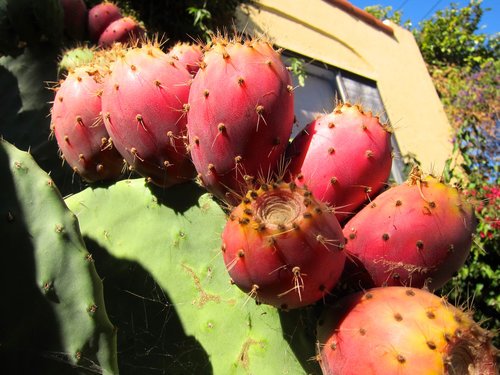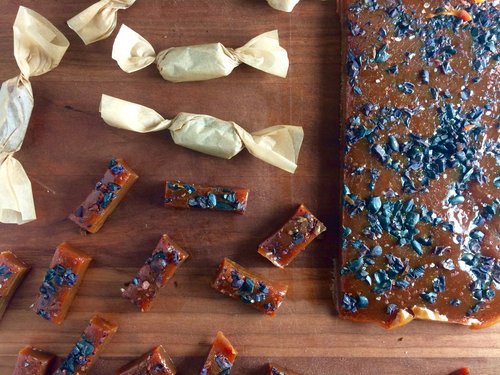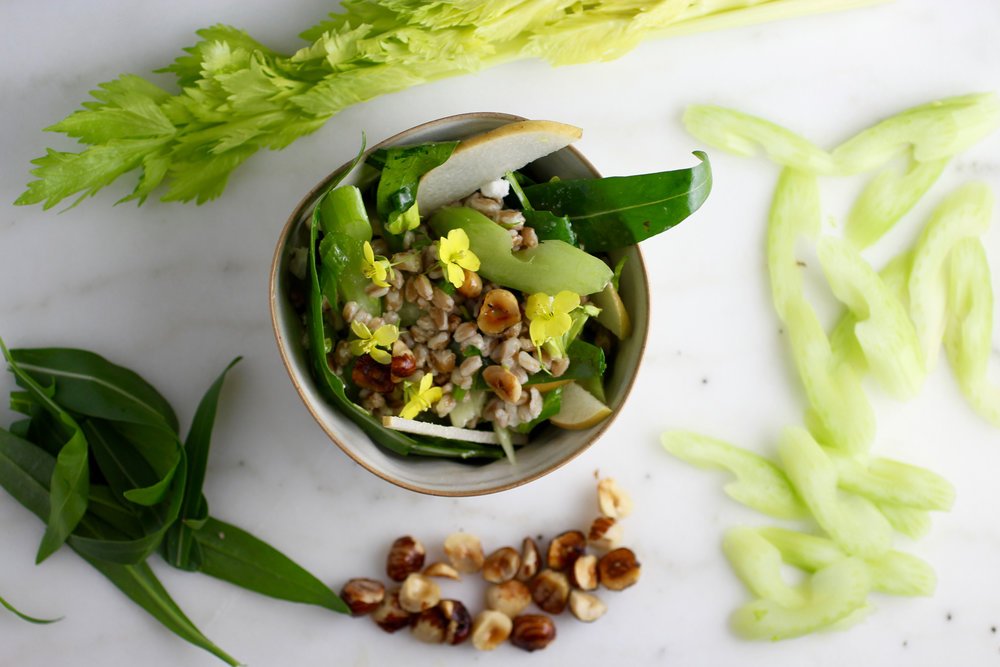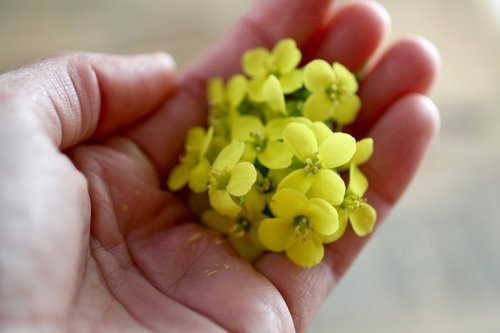Prickly pear salty caramels
Prickly pear margaritas, prickly pear sorbet, prickly pear cheesecake, prickly pear fermented beverage, prickly pear marinade - you name it, I've tried it with prickly pear. This is primarily because at my house in Oakland has a giant prickly pear cactus (Opuntia) that is very, VERY productive. Like, part-time job in the late summer/fall productive. At first, I was so pumped that I wasn't very generous with the fruit, but now, when I hear someone comment on the prickly pear cactus (which happens quite often) I run out and give them a bag of frozen fruit. You can read more about my harvesting methods here. Since there's so much fruit, I now pretty much stick to the second process listed, which is a loss of the pulp, but dramatically less work.
Cutting caramels into squares.
A few years ago, in an effort to get rid of as much juice as possible, I was trying to think of recipes where reducing the juice was required. I remembered making apple cider caramels at some point, so I decided to give that a try using this Smitten Kitchen recipe for apple cider caramels, but substituting out cider for prickly pear juice. There are also a few other changes, like adding cacao nibs to the top and omitting cinnamon (wouldn't be bad, but just already a lot going on). The caramels were above and beyond my expectations - a deep, rich sweetness balanced by the salt and toasty cacao nibs. Really so, so good and now my favorite prickly pear concoction. Additionally, they can be wrapped and keep well, so a great unique holiday gift item! Recipe makes about 50 caramels, depending how large they are cut.
4 cups (945 ml) prickly pear juice
8 tablespoons (115 grams or 1 stick) unsalted butter, cut into chunks
1 cup (200 grams) granulated sugar
1/2 cup (110 grams) packed light brown sugar
1/3 cup (80 ml) heavy cream
Up to 1/4 cup cacao nibs
Up to 2 teaspoons flaky sea salt, such as Maldon, or less of a finer salt
Neutral oil for the knife, if needed
Boil the prickly pear juice in a 3- to- 4- quart saucepan over high heat until it is reduced to a dark, thick syrup, about 1/2-3/4 cup in volume. This takes about 40-60 minutes on my stove. Stir occasionally.
Meanwhile, get your other ingredients in order, because you won’t have time to spare once the candy is cooking. Line the bottom and sides of an 8- inch square metal baking pan with 2 long sheets of crisscrossed parchment. Set it aside. Put salt and cacao nibs in a small dish.
Once you are finished reducing the juice, remove it from the heat and stir in the butter, sugars, and heavy cream. Return the pot to medium- high heat with a candy thermometer attached to the side, and let it boil until the thermometer reads 252 degrees, only about 5 minutes. Keep a close eye on it. Stir occasionally. (Don’t have a candy or deep- fry thermometer? Have a bowl of very cold water ready, and cook the caramel until a tiny spoonful dropped into the water becomes firm, chewy, and able to be plied into a ball.)
Immediately remove caramel from heat and give the caramel several stirs to distribute it evenly. Pour caramel into the prepared pan then sprinkle with cacao and salt. Let it sit until cool and firm—about 2 hours, though it goes faster in the fridge. Once caramel is firm, use your parchment paper sling to transfer the block to a cutting board. Use a well- oiled knife, oiling it after each cut (I have never had to do this...), to cut the caramel into 1-by-1-inch squares or 0.5-by-2-inch. Wrap each one in a larger piece of parchment or wax paper, twisting the sides to close. Caramels will be somewhat on the soft side and will keep for 2 weeks at room temperature, 1 month in the refrigerator.
Autumn crunch farro salad with Asian pear, celery, and toasted hazelnuts
Autumn crunch farro salad.
Wholesome, flavorful, crunchy.
By way of a recommendation from a food-minded friend, I was lucky enough to visit the restaurant Ned Ludd on a recent trip to Portland. Defining itself as "an American craft kitchen", Ned Ludd has all of the charm and menu items you'd expect in a Pacific Northwest restaurant with a photo of an axe in the woods on their homepage. Various pickled things, roasted brassicas, and charcuterie definitely make an appearance, as does other "good food that tells a story". Apart from delectable dishes including their delicious grilled flat bread served with olive oil (salivating just thinking about the doughy goodness), another menu item that I recall is one that we actually didn't order - a whole grain salad with a bunch of different chopped ingredients reminiscent of autumn. I specifically made a mental note to take the inspired ingredient combination of farro, arugula, asian pear, celery, toasted hazelnuts, and chevré, and try it at home. While I'm not sure if this is exactly like what they served, as again, we didn't order it, the salad was unique and delicious so I consider it an inspired-recipe win!
The fall is fading fast, but it's not too late to make use of the harvest with this salad. Also, farro is technically considered an "ancient grain" (a grain that is loosely defined as not having changed much over the last several hundred years), which is fun from a culinary sustainability standpoint and a stellar grain to have in your toolbelt. Below is an approximation (feel free to add more or less of whatever you have on hand!) and serves 4.
1 cup cooked farro*
2 large celery stalks, thinly sliced
1 asian pear, cored and thinly sliced
2 cups arugula
About 1/4 teaspoon Kosher or sea salt
Juice of 1 lemon
2 tablespoons olive oil
1-2 ounces fresh goat cheese (chevré), crumbled
1/4 cup toasted hazelnuts**
Arugula or other edible flowers for garnish (completely optional, I just happened to have arugula and flowers growing in my raised bed)
Toss farro with celery, pear, and arugula. Salt to taste.
Put lemon juice, olive oil, and a few pinches of salt in a small mason jar. Shake until combined then toss into farro mixture followed by goat cheese and hazelnuts, reserving a few to add to top.
Garnish with edible flowers (optional) and serve immediately.
*There are many ways to cook farro, but I usually just use 1 part farro to 2 parts liquid (water in this case), bring to a boil, reduce to a simmer, cover, and cook for about 30-40 minutes until farro is "al dente" (because I like it kind of firm), but soft enough to chew. In this instance, about 1/3 cup farro + 1 cup water will yield about 1 cup cooked farro. Some recipes call for cooking farro like pasta, but I feel that is an unnecessary waste of water.
**To toast hazelnuts, heat in a cast iron pan on medium-high until browned, tossing frequently, about 2 minutes and sprinkle with salt. A small amount of oil can be added to the pan and tossed with the nuts if you'd prefer a richer toasted nut.
Arugula flowers for garnish that I happened to have from my raised bed arugula - not at all mandatory, but always fun to include some edible flowers!







